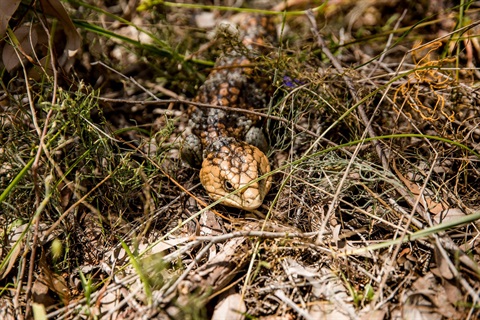Find out information about our reptilian friends who live in the Kensington Bushland area.
Buchanan's Snake-eyed Skink
Cryptoblepharus buchananii
Conservation Status: Least concern
Distribution: Occurs throughout mid- and southern WA in a variety of habitats including suburban gardens, woodlands and shrublands.
Description:
The Buchanan’s Snake-eyed (or Fence) Skink measures up to 11cm long (snout-vent length of 5cm) and is brown with a complex, ragged pattern that includes a dark zone down their spine and two broken stripes on either side. These stripes extend from the eye to the tail and are formed of scattered spots on their upper surface. This skink is small, glossy-scaled and has greyish brown to brown flecks across its body.
Curious Facts:
- This agile hunter is sometimes called the Wall or Fence Skink in the suburbs as it can move swiftly on vertical surfaces in search of insects.
- Buchanan’s Snake-eyed Skinks are the most commonly seen reptile in the Perth region, frequently seen on human structures such as walls and fences.
- At Kensington Bushland, this skink often suns itself on large fallen logs and forages for invertebrates in the cracks and holes of these logs.
References:
Wilson, S and Swan, G 2017, Reed New Holland Publishers, A Complete Guide to Reptiles of Australia.
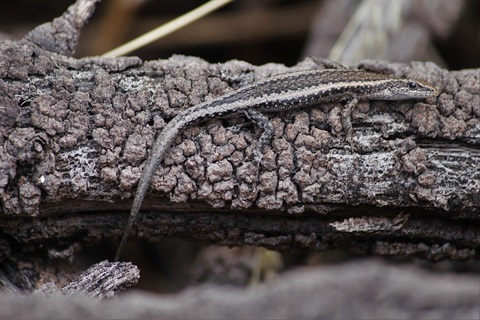
Common Dwarf Skink
Menetia greyii
Conservation status: Least concern
Distribution: Occurs throughout Australia, excluding the eastern coasts of QLD and NSW, and much of VIC and TAS. They are widespread in dry areas on a variety of soils and open vegetation types.
Description:
The Common Dwarf Skink is Australia’s smallest reptile, measuring five centremetres long. They are brownish grey to grey with white and have black flecks across their body. A white and dark stripe runs from underneath the eye, extending onto the body.
Curious facts:
- The genus Menetia consists of five tiny species of skink that are secretive and active during the day.
- These lizards bask, shelter and forage among leaf litter, rarely venturing into exposed areas.
- Common Dwarf Skinks feed on invertebrates and lay eggs.
References:
Wilson, S and Swan, G 2017, Reed New Holland Publishers, A Complete Guide to Reptiles of Australia.
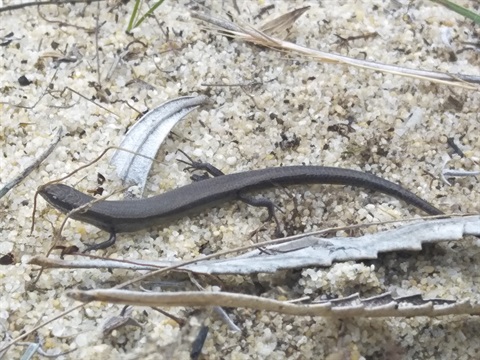
Dugite
Pseudonaja affinis
Noongar name: Dobitj
Conservation status: Least concern
Distribution:
Occurs throughout south-western WA. Their distribution extends eastwards across the Nullarbor Plain from north of Perth to the Eyre Peninsula, SA.
Description:
Dugites are extremely variable in colouration, pattern and size through their distribution, however Kensington Bushland specimens tend to be coloured dark brown or black (exhibit melanism) and reach total lengths of up to 1.5 metres. Juvenile Dugites have a black head and nape with dark flecks on the body forming a herring-bone pattern.
Curious facts:
- Dugites are known to be cannibalistic, however they normally prey on small mammals and lizards.
- The Dugite appears to be the only species of snake to occur in Kensington Bushland. It is the most common snake in the Perth region, with 90% of snake encounters in urban areas being with Dugites.
- They are usually most active from early spring through to early autumn (October to April). During this period, male Dugites are actively seeking out females to mate with.
- Dugites are naturally shy, preferring to avoid humans. If they are cornered or given no route to escape, they will raise their forebody and hiss loudly. It is highly unlikely that you’ll be bitten if you leave it alone.
References:
Wilson, S and Swan, G 2017, Reed New Holland Publishers, A Complete Guide to Reptiles of Australia.
Australian Museum information on Dugites
Perth Zoo information on Dugites
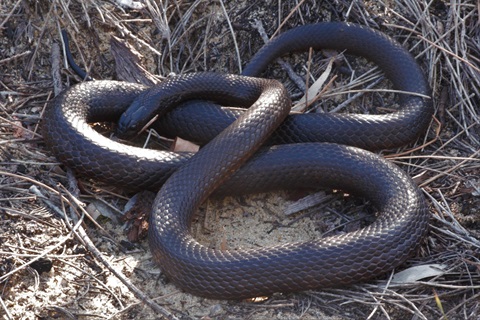
Elegant Slider
Lerista elegans
Conservation status: Least concern
Distribution:
Elegant Sliders occur from Monte Bello Island (north-east of Onslow) to Augusta, inhabiting sandy coastal plains. They shelter under rocks, logs and leaf litter.
Description:
This species measures up to 7.5cm long and is grey to brown, with a broad black stripe on the side of the body. Underneath this stripe, there is a thin white stripe. There are two series of dark dashes on the top of the body that almost form lines. There is often a red flush on the tail, especially in juveniles.
Curious facts:
- Leristas are terrestrial burrowers that are endemic to Australia. They lay eggs and feed on invertebrates.
- Unlike other skinks at Kensington, they have a snout that is shaped like a shovel.
- There are 93 species of Lerista in Australia, of which eight occur in the Perth region (one in Kensington).
- The genus Lerista contains species that range from unspecialised inhabitants of leaf litter to shovel-snouted sand-swimmers that have adapted to dwelling underground.
References:
Wilson, S and Swan, G 2017, Reed New Holland Publishers, A Complete Guide to Reptiles of Australia.
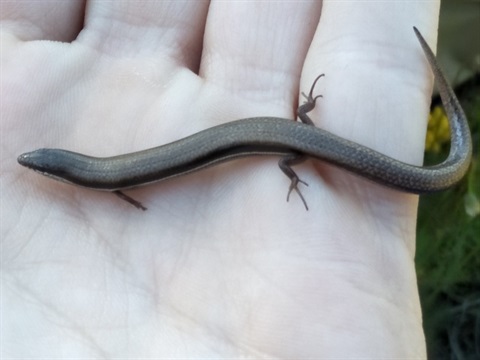
Two-toed Earless Skink
Hemiergis quadrilineata
Conservation status: Least concern
Distribution:
Only occurs on the lower west coast of WA and offshore islands on sandy and limestone-based soils. They are rarely found in woodlands on heavy soils. It is commonly found in gardens of suburban Perth.
Description:
Two-toed Earless Skinks are long-tailed and can measure up to 10cm long. They range in colour from pale to dark reddish brown, yellowish brown or greyish brown with two lines of black dashes down their spine. Their belly is bright yellow.
Curious Facts:
- The genus Hemiergis comprises seven small, long-bodied species that possess very short limbs.
- They are secretive, dwelling in loose damp soil under logs, leaf litter and rocks.
- Earless Skinks feed on small invertebrates and give birth to live young.
- Due to the non-functionality of their limbs and snake-like movement, they are often mistaken for a small snake.
References:
Wilson, S and Swan, G 2017, Reed New Holland Publishers, A Complete Guide to Reptiles of Australia.
Wikipedia
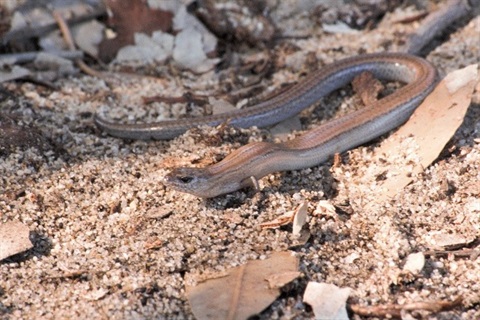
West Coast Long-tailed Ctenotus
Ctenotus australis
Noongar names: Djidong, Barri-barri or Wandi-wandi (Small Lizard)
Conservation status: Least concern
Distribution:
C. australis is native to coastal areas in the southwestern part of WA where it is found amongst heath on coastal dunes, and in open woodland on the Swan Coastal Plain. It is generally restricted to areas with limestone. Within the Victoria Park area this skink is common in both Kensington and Hillview Bushlands.
Description:
The West Coast Long-tailed Ctenotus has a body length of around 100mm long. The tail can be up to two and a half times the length of the body. It is a light brown colour, but over this is a complex, prominent pattern of black, white and brown stripes. Similar to Ctenotus fallens (West Coast Ctenotus) but has a back pattern that includes six narrow white lateral stipes along its body instead of four.
Curious facts:
- The largest group of lizards in Australia belong to the genus Ctenotus. There are nearly 100 species in this genus. They are found throughout much of Australia, but are most diverse in the desert regions and tropical woodlands of Australia's north.
- Lizards of the Ctenotus genus are commonly called 'comb-eared skinks' because of the row of small scales on the anterior edge of their ears.
- For many Australian temperate-zone skinks, the tail is the major energy storage organ, especially in species such as C. australis that lack the ability to store body fat.
References:
Bush, B et.al 2010, Western Australian Museum, Field Guide to Reptiles & Frogs of the Perth Region.
Australian Museum
Friends of Queens Park bushland
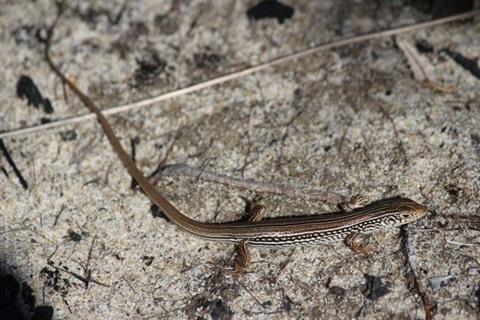
Western Bearded Dragon
Pogona minor minor
Conservation status: Least concern
Distribution:
The Perth subspecies of the Dwarf Bearded Dragon occurs throughout WA (excluding the Pilbara and Kimberley regions), the western half of SA and south-western NT. They occur in woodlands, rocky outcrops and shrublands.
Description:
Adult bearded dragons can measure up to 35cm long with a snout-vent (vent refers to the start of the tail) length of between 11 and 16cm. The Perth subspecies is moderately slender and narrow-headed, with a row of spines along each side of the nape. They range in colour from grey to greyish brown, occasionally with a yellowish tinge.
Curious facts:
- The Dwarf (or Western) Bearded Dragon is Kensington Bushland’s only species of dragon lizard.
- Changes colour according to circumstances. Cold, inactive lizards are dark grey, changing to yellowish brown as they warm and become active.
- Bearded dragons are fond of basking on bitumen roads to warm themselves up, leading to unfortunate consequences.
References:
Wilson, S and Swan, G 2017, Reed New Holland Publishers, A Complete Guide to Reptiles of Australia.
Bush Heritage
Kanyana Wildlife
Wikipedia
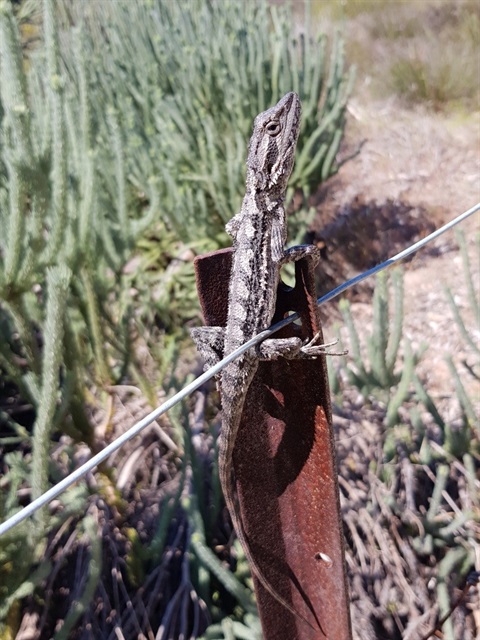
Western Bobtail
Tiliqua rugusa rugusa
Noongar name: Yorna
Conservation status: Least concern
Distribution:
Occurs throughout southern Australia and the interior of QLD, SA and NSW. It inhabits open and dry habitats such as woodlands, shrublands, coastal dunes and forests.
Description:
The Perth subspecies of Bobtail is variable in colour, ranging from olive to dark shades of brown with irregular pale bands on the body and tail. The head is often paler than the body and is generally flushed with orange. Juveniles are more strongly coloured and patterned than adults. Bobtails can reach a maximum length of 41cm.
Curious facts:
- Bobtails have various common names including Shingleback, Stumpy-tail, Pinecone Lizard and Boggi.
- Pairs appear to mate for life, meeting each spring.
- The word ‘rugosa’ means ‘rough’, most likely referring to the large scales that cover the body of the lizard.
- Bobtails can live up to 30 years in the wild.
References:
Wilson, S and Swan, G 2017, Reed New Holland Publishers, A Complete Guide to Reptiles of Australia.
Healthy Wildlife
Kanyana Wildlife
